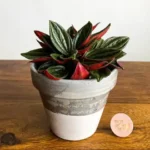Meet the Calathea Zebrina: A Foliage Showstopper
Known for its striking zebra-like striped leaves and elegant presence, Calathea zebrina is a standout among indoor foliage plants. This plant, also known as the zebra plant (not to be confused with Aphelandra squarrosa), is native to southeastern Brazil and thrives in humidity-rich tropical environments. In the home, it serves as a decorative houseplant that demands a bit of love and care, perfect for plant lovers who enjoy a rewarding challenge.
Understanding Calathea Zebrina’s Growing Needs
Like its relatives in the Marantaceae family (prayer plants), the Calathea zebrina is sensitive to its surroundings. Offering the right balance of light, humidity, water, and temperature is essential for maintaining its vibrant appearance.
Light Requirements
Calathea zebrina does best in bright, indirect light. In its natural rainforest habitat, it grows under the canopy of taller trees, so direct sunlight will scorch its soft, velvety leaves. Place it near an east- or north-facing window or a few feet back from a south-facing window with a sheer curtain.
- Too much light: Leaves will fade or develop brown, crispy patches.
- Too little light: Growth becomes leggy, and leaf patterns fade.
Temperature and Humidity
This plant loves warmth and moisture. To mimic its native environment:
- Temperature: Keep between 65–75°F (18–24°C). Avoid cold drafts and sudden temperature drops.
- Humidity: Aim for at least 50-60%. Higher is better. Use a humidifier or place the plant on a pebble tray with water. Kitchens and bathrooms often provide naturally higher humidity levels, making them good placement options.
Watering Tips
Watering Calathea zebrina requires a little finesse. It likes to stay evenly moist but never soggy.
- Use filtered or rainwater: Tap water containing fluoride or chlorine can brown the leaf edges over time.
- Water when the top inch of soil feels dry: Stick your finger into the soil or use a moisture meter to check.
- Allow excess water to drain: Never let the plant sit in standing water, as this can lead to root rot.
Soil and Potting Requirements
A light, well-draining potting mix is crucial. Calatheas dislike compacted or heavy soil.
- Ideal mix: Combine peat or coco coir, perlite, and a bit of orchid bark for aeration and moisture control.
- Pot with drainage holes: This helps prevent water buildup and root problems.
Routine Care and Maintenance
Fertilizing Schedule
Feed your Calathea zebrina during the growing season (spring through early fall) with a diluted, balanced liquid fertilizer every 4-6 weeks. Avoid overfeeding, which can result in salt buildup or leaf burn.
Pruning and Grooming
Regular upkeep keeps your plant looking tidy and healthy.
- Remove yellow or brown leaves: Use clean scissors to prune at the base of the leaf stem.
- Wipe leaves occasionally: Dust can build up on soft leaves. Wipe gently with a damp cloth to keep them clean and shiny.
Repotting
Repot every 1-2 years or when you notice roots poking out of the drainage holes. Choose a pot one size larger and refresh the soil to keep it nutrient-rich.
Pest and Problem Management
Calatheas are fairly resilient but can be prone to a few pests and common care issues.
Common Pests
- Spider mites: Fine webbing and tiny red or white specks on leaves. Increase humidity and use neem oil or insecticidal soap.
- Fungus gnats: Often a result of overly moist soil. Let the topsoil dry between waterings and use yellow sticky traps or beneficial nematodes.
Common Leaf Issues
- Brown edges: Often caused by low humidity, too much fertilizer, or tap water with chemicals.
- Curling leaves: Sign of underwatering or low humidity.
- Yellow leaves: Could indicate overwatering or poor drainage.
Adjust your conditions when leaf issues appear and the plant will usually bounce back with proper care.
Tips for Success with Calathea Zebrina
- Consistency is key: Calatheas thrive with reliable care routines.
- Observe your plant: It will often tell you what it needs through changes in leaf color and texture.
- Group with other plants: Helps raise local humidity levels, especially in drier environments.
- Avoid frequent moving: Calatheas can be sensitive to relocation, especially to spots with different lighting or air flow.
Final Thoughts
The Calathea zebrina is more than just a decorative plant—it’s a living piece of art. While it does require attention to its specific needs, the glowing green leaves striped with darker emerald hues are a uniquely satisfying reward. For indoor gardeners willing to meet its tropical demands, this plant becomes a high-impact member of your collection, turning any corner of your home into a green retreat. With patience, attentiveness, and the right tools, your Calathea zebrina will thrive and impress for years to come.
References
- Hessayon, D. G. (2013). The House Plant Expert. Expert Books.
- Griffith, M. P., Calonje, M., & Francisco-Ortega, J. (2011). Diversity, relationships and conservation of the Marantaceae. Botanical Journal of the Linnean Society, 165(4), 336–349.
- University of Florida IFAS Extension. (n.d.). Calathea zebrina, Zebra plant. Retrieved from https://gardeningsolutions.ifas.ufl.edu








